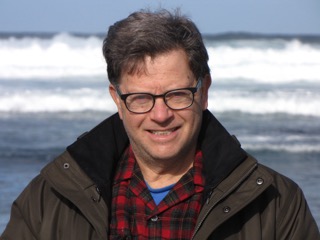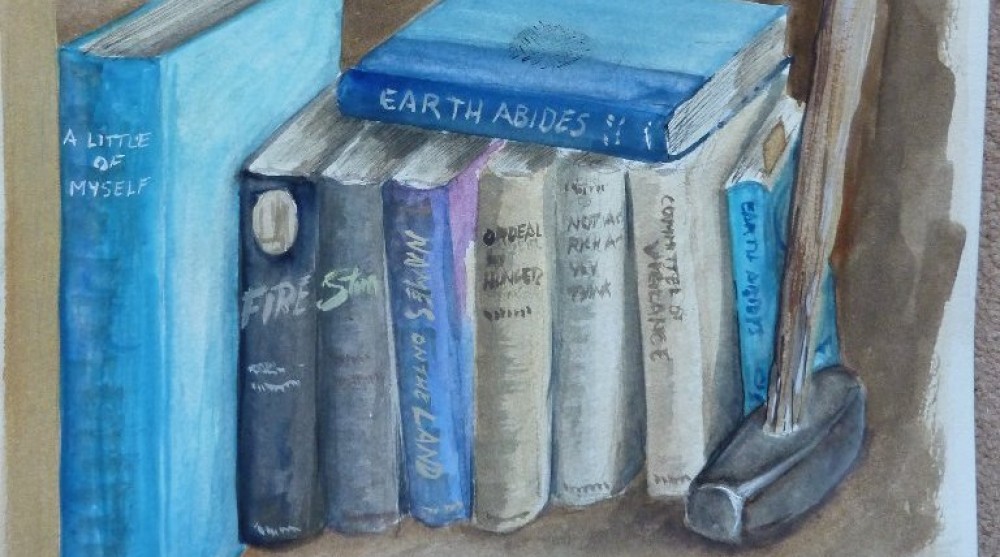
Born in New York City, and speaking with a distinct accent, Alan Kaplan brought a distinctive character to his work as a Naturalist for the East Bay Regional Parks. Based in Tilden Regional Park, in the hills behind Berkeley, Alan interpreted the history and natural history of the area through guided hikes, school programs, and the preparation of exhibits for many years, until his retirement. He’s also provided leadership in organizations that provide education in interpretation for his fellow naturalists in the west, through his work in the old Western Interpreters Association. (Note that “interpreter” in the park sense refers to what used to be called “naturalists” – those people in distinctive uniforms who interpret the advanced concepts of a park’s cultural and natural history into common English for visitors.)
That’s where I first met him. There, he played a foundational role in the publication of the George R. Stewart biography. He was the First Publisher of my writings about GRS.
In 1986, the WIA conference was held in Yosemite National Park. I presented a talk, “George R. Stewart: An Author for Interpreters.” As the the title implies, Stewart’s histories and ecological novels are excellent resources for those interpreting the natural or human history of the West.
I was pleasantly surprised when Alan, then President of WIA, encouraged conference attendees to attend the GRS session. And even more pleasantly surprised when the session was crammed full of enthusiastic naturalists and interpreters.
As the session ended, Alan, who was in the audience, rose to second my comments about Stewart’s value for interpreters. He emphasized the power of Stewart’s writing by quoting the closing lines of FIRE. Doing so, he even educated me – I knew FIRE well, but had never given the ecological power of its closing such careful attention. (FIRE was so well-researched and written that the U.S. Forest Service used it in their training programs for summer fire lookouts.)
Alan asked for an article for the WIA Newsletter, Bayways. Entitled “The Man Who Named The Wind,” the article was a written summary of the GRS talk. It was the first publication, for a large audience, of material which would eventually expand into the McFarland biography.
Alan also interpreted the work of George R. Stewart to Tilden Regional Park visitors. For many years, on a weekend close to the day in August when Stewart died, Alan led a “George R. Stewart Memorial Hike” to the summit of one of Tilden’s peak . The hike focused on Stewart’s work, especially his remarkable NAMES ON THE LAND. The book is not a dictionary of American place names, but a history which explains in beautiful prose WHY we named places a certain way in a certain era. As Wallace Stegner once wrote about NAMES (here paraphrased) “No one ever wrote a book like this before; no one has written one since.” Visitors who joined Alan’s hike learned about Stewart, his work, and especially his unique work about place-naming. (NAMES ON THE LAND has just been translated into Chinese for the millions of citizens of that country who are enamored of American culture.)
Once, friends and I joined Alan on the hike: George and Theodosia’s son Jack, Jack’s wife Joyce, and former high school student Denise L. Barney and her husband Barney hiked along; afterward we crammed into the back of the tiny Chinook microcamper with Alan to share some good wine and crackers (Alan abstained!)
As the GRS biography was written, and published, Alan joined public events which described GRS and my work. Once, to my chagrin, he was at a talk at the Bancroft Library and I did not notice him so did not introduce him; fortunately, when he came up afterward to say hello I was able to give him a well-deserved gift – a first edition of STORM, autographed by GRS, with a rare misprint on one page.
He also shared our GRS dinner at the beautiful, historic UC Berkeley Faculty Club, sitting next to me, and we were able to talk about shared GRS experiences.
To sum up – Alan Kaplan, Naturalist, played a major role in the work which led to the eventual publication of THE LIFE AND TRUTH OF GEORGE R. STEWART. He also inspired me to take a second, deeper look at Stewart’s books, especially FIRE. Stewart, and the GRS biography owe him much. I am deeply grateful for his encouragement.

I ran into George R Stewart in a Berkeley coffee shop one evening around 1978. I told him that I much admired his books and in particular the Earth Abides. I asked him if Jack London’s The Scarlet Plague was his inspiration. He smiled at me, noted the obscurity of the novel, and said “Of Course.” We also discussed his role on not signing the McCarthy era Loyalty Oath in the 1950s. I remember having to take the oath to TA freshman calculus when I was a graduate student in the Math department.
Thanks, Charles Gray. Interesting information about Stewart and The Scarlet Plague.
One correction: GRS DID sign the oath – his slogan was “Sign, stay, and fight.” He knew that if he signed they could not fire him; and he could join with others, protesting that illegal law surreptitiously while still connected with the campus. Of course, his protest was effective – he wrote The Year of the Oath, which caused the death of the oath. Now the corporate state has been forced to use different means to politicize and control education.